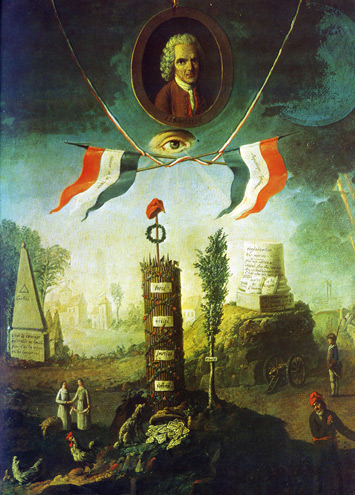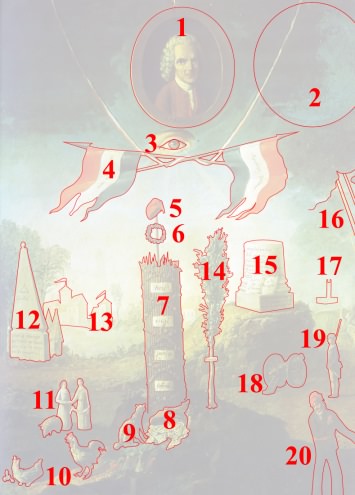 |
| click to embiggen |
An Allegory of the Revolution with a Portrait Medallion of Jean-Jacques Rousseau (1712-78) by Nicolas Henri Jeaurat de Bertry, 1794, oil on canvas.
Jean-Jacques Rousseau died in 1778 and the French Revolution started 1789. By 1794, when this was painted the Reign of Terror was nearing an end.
 |
| elements of the painting |
Elements of the painting
1. Top center is a medallion portrait of Jean-Jacques Rousseau labeled "J. J. Rousseau" hangs from a gold cord in the sky. The medallion as a painting in a painting is a trompe l'oeil effect. Rousseau looks old and stern.
2. to the right of the portrait is a circular blob. Perhaps it is supposed to be the cover to the portrait like a locket.
3. below the portrait is the all-seeing eye (or Eye of Providence) with light radiating symbolizing the supreme being. An all seeing eye seems specifically about being watched and judged. (while this is a conventional depiction of the all seeing eye, it is interesting that it is not just the eye or the eye and eyelids but it is the eye, eyelids and also an eyebrow)
4. below that is a pair of French Tricolor flags on flagpoles with spear shaped finials suspended by a red, white & blue ribbon with text written on them :
- written on the left flag : "amour de la patrie" (patriotism ; literally "love of the fatherland")
- written on the right flag : "Republique francaise" (French Republic)
- The French Tricolor was adopted in 1794 and replaced the King's flag of a white field with yellow fleur-de-lis and a blue shield
- the flags and portrait are hanging from an unknown source.
5. below the flags is a Phrygian cap (aka a liberty cap, aka a red smurf hat) a symbol of freedom. The cap rests at the top of a Liberty Pole.
6. below the cap is a laurel wreath. Being round it might symbolize eternity but it is usually a symbol of victory.
7. the Phrygian cap rests on a bundle of sticks and axes (specifically a fasces) symbolizing order and "strength through unity." The fasces originated with the Roman Republic and it's use during the revolution was intended to harken back to that past. The fasces are bound together in flower garlands and has 4 labels on it :
- "force" (force)
- "vérité" (truth)
- "justice" (justice)
- "union" (union)
8. below the fasces is what appears to be a sack of papers (I can't tell what is written on them). The sack kind of looks like a horn of plenty (cornucopia) which is a symbol of abundance. Below the cornucopia appears to be spring water coming out of the ground.
9. next to the sack a sitting dog looks up at the fasces symbolizing loyalty.
10. on the bottom left is a hen with chicks being watched by a cock (rooster). The rooster is symbol of France, ancient Gaul and in particular the Republic aka Coq Gaulois (the Gallic Rooster). Perhaps, together they are a symbol of family.
11. above the chickens are two women in modest dresses, almost robes, standing hand in hand are holding a label that says something I can't make out. A handshake is a symbol of fraternity. Next to the women appear to be a single sheep. A sheep may represent a religious flock or those to be shepherded. The sheep may be too large to be considered a sacrificial lamb.
12. above and to the left of the women is a triangular obelisk marked with a triangle and "Egalité" (equality) and on the rectangular part of the obelisk is inscribed "c'est le courage qui établit les republique; C'est la vertu qui les conserves" (It is the courage that sets republic; This is the virtue that preserves.)
- the triangle might be used as a symbol of balance
- the triangle might be a reference to the Three Estates : the First Estate (clergy); the Second Estate (nobility); and the Third Estate (commoners)
- to the right and behind the obelisk are 2 triangular things that could be 2 more obelisks but I'm not sure. They look more like elongated huts. They could be beehives – a symbol of industriousness and co-operative action (in particular : a skep, a upsidedown basket covered in mud to provide a home for bees).
- The lack of symmetry of the large obelisk is clear. Is the obelisk supposed to be a right triangle while the inscribed triangle is an equilateral triangle?
- The tree behind and to the right of the obelisk appears distinctly different than the other trees. It bears a fruit at top but it is unclear what type of tree it is.
13. in the far left background is a village with a French tricolor flag atop two buildings.
14. to the right of the fasces is a tree labeled "Liberté" (liberty) : a Liberty Tree. Liberty, like a tree, is more likely to thrive if it is nurtured.
15. to the right of the tree is a partial column "régénération des moeurs – plus une nation est eclairée plus elle sent que Son véritable intérêt est d'obéir a des loix justes et sage – Fénélon" (Regeneration of the morals. The more a nation is illuminated more she feels that his real interest is to obey just laws and has wise – Fénélon) The sentence between the dashes is a quote from François Fénélon (1651-1715) a critic of the monarchy.
- leaning against the column are 2 tablets inscribed "droits de l'homme" (rights of man) and "et du citoyen" (and of the citizen)
- the column rests on a plinth labeled "peint et donné par le of Jeaurat. l'art a de la republique fin 20 _____ 1794" (paint and given by Jeaurat. The art of the Republic finished 20 _____ 1794) The _____ could be "ventos" although February by the Revolutionary calendar is Ventôse this doesn't appear to match.
16. to the right of the flags are rays of light breaking through the clouds. Symbolic of a new beginning and the end of the storm.
17. in the far right background is a guillotine – a symbol of death, the Terror, mass executions, the revolution, and the end of the monarchy.
17. in the far right background is a guillotine – a symbol of death, the Terror, mass executions, the revolution, and the end of the monarchy.
18. next to the column is a wheeled cannon (a six pounder?) – a symbol of the French battles against Austrian and Prussian attempts to squash the revolution.
19. next to the cannon is a soldier in a blue & white uniform standing with a rifle on his shoulder. Note that he is wearing knee breeches so he is not a sans-culottes
20. the lower right corner is a man with a mustache in a red Phrygian cap and red belt. He appears to be a sans-culottes. He appears to be looking at the viewer and making a dramatic gesture while out of his right hand he is dropping a handful of something (earth perhaps) or he could be sowing seeds (very large seeds).
Not seen due to the right side of the reproduction being cut off : to the right of the column (#15) are some ruins and a second partial column with writing on it. Since this reproduction is cut off then contrary to the scan above the central elements (the portrait, fasces) are actually more off center and towards the left. Here is the complete image.
 |
| Liberty Leading the People, 1830 by Eugène Delacroix. |
In contrast, in my opinion, a much better painting also about a French revolution (the July Revolution, 1830) is Liberty Leading the People, 1830 by Eugène Delacroix.
Unlike the Jeaurat, the Delacroix is not just a group of symbols just standing there sharing the same space. Delacroix's symbols are doing something discernible.
The portrait of Rousseau is placed above the all seeing eye – above the depiction of a deity. Is that making an intentional symbolic point or is it just incidental? Is it important that the males (including the rooster) are all to the right of the females? What if the symbolism changes? A cock, for example, might symbolize one thing in revolutionary France but something entirely different a few hundred years later.
What if people don't know the symbolic language? That may be the point. Jeaurat's painting might be intended to be seen as a coded message and as a test of knowledge.
If you have to label things in your painting then I think you are probably doing something wrong.


2 comments:
Thanks for this, quite helpful for us teachers. And thanks for your blog, which is invariably interesting.
Isn't that blob thing at the upper right meant to be the Moon?
Post a Comment